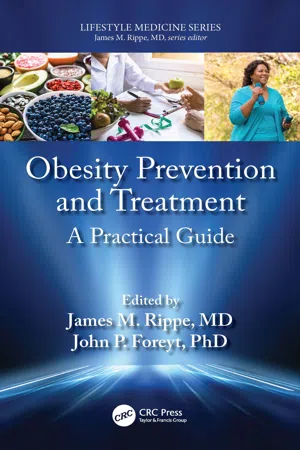
Obesity Prevention and Treatment
A Practical Guide
- 230 pages
- English
- ePUB (mobile friendly)
- Available on iOS & Android
Obesity Prevention and Treatment
A Practical Guide
About this book
The World Health Organization estimates that there are 2.1 billion individuals with obesity globally. Nearly three quarters of adults in the United States are overweight or obese. The average individual with obesity cuts ten years off their life expectancy, yet less than 40% of physicians routinely counsel individuals concerning the adverse health consequences of obesity. Obesity Prevention and Treatment: A Practical Guide equips healthcare practitioners to include effective weight management counselling in the daily practice of medicine.
Written by lifestyle medicine pioneer and cardiologist, Dr. James Rippe and obesity expert Dr. John Foreyt, this book provides evidence-based discussions of obesity and its metabolic consequences. A volume in the Lifestyle Medicine Series, it provides evidence-based information about the prevention and treatment of obesity through lifestyle measures, such as regular physical activity and sound nutrition, as well as the use of new medications or bariatric surgery available to assist in weight management.
- Provides a framework and practical strategies to assist practitioners in safe and effective treatments of obesity.
- Contains information explaining the relationship between obesity and increased risk of heart disease, diabetes, cancer, osteoarthritis, and other chronic conditions.
- Chapters begin with bulleted key points and conclude with a list of Clinical Applications.
Written for practitioners at all levels, this user-friendly, evidence-based book on obesity prevention and treatment will be valuable to practitioners in general medicine or subspecialty practices.
Frequently asked questions
- Essential is ideal for learners and professionals who enjoy exploring a wide range of subjects. Access the Essential Library with 800,000+ trusted titles and best-sellers across business, personal growth, and the humanities. Includes unlimited reading time and Standard Read Aloud voice.
- Complete: Perfect for advanced learners and researchers needing full, unrestricted access. Unlock 1.4M+ books across hundreds of subjects, including academic and specialized titles. The Complete Plan also includes advanced features like Premium Read Aloud and Research Assistant.
Please note we cannot support devices running on iOS 13 and Android 7 or earlier. Learn more about using the app.
Information
Section I
The Modern Management of Obesity
1 Preventing and Managing Obesity
The Scope of the Problem
CONTENTS
- 1.1 Introduction
- 1.2 The Burden of Overweight and Obesity in the United States
- 1.3 Health Effects of Obesity
- 1.4 Searching for Solutions
- 1.5 Need for Healthcare Professional Involvement
- 1.6 Summary/Conclusions
- 1.6.1 Clinical Applications
- References
1.1 INTRODUCTION
1.2 THE BURDEN OF OVERWEIGHT AND OBESITY IN THE UNITED STATES
1.3 HEALTH EFFECTS OF OBESITY
- Role of adipocytes: It used to be thought that adipocytes were primarily storage sites for excess fat. Research over the last two decades, however, has clarified that adipocytes are, in fact, highly complicated inflammatory, endocrine, and metabolic cells [14,15,16,17]. Essentially, adipose tissue thus serves as a complicated endocrine organ and a potent source of inflammatory molecules such as IL-6, Tumor Necrosis Factor alpha (TNFα), and many others [15]. The complex properties of adipocytes appear to underlie the strong relationship between obesity and a variety of chronic medical conditions such as coronary heart disease (CHD), T2DM, and MetS. The complex metabolic and inflammatory properties of adipocytes seem particularly prominent in those located in the abdominal region.
- Health effects in adults: The adverse health consequences of obesity are diverse and profound. As already indicated, obesity is strongly associated with T2DM (see Chapter 13), metabolic syndrome (see Chapter 14), CHD (see Chapter 12), and some cancers (see Chapter 15), as well as arthritis (see Chapter 16). This list of adverse health consequences of obesity is by no means exhaustive. A more complete listing is found in Table 1.1.
|
Table of contents
- Cover
- Half Title
- Series Page
- Title Page
- Copyright Page
- Dedication
- Table of Contents
- Preface
- Acknowledgments
- Editors
- Contributors
- Section I The Modern Management of Obesity
- Section II Obesity and Specific Medical Conditions
- Section III Future Directions and Public Health Issues
- Index